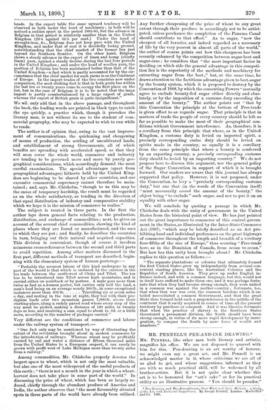MR. PENNELL'S PEN-AND-INK DRAWING.*
Ma. PENNELL, like other men both literary and artistic, magnifies his office. We are not disposed to quarrel with him for this. = Pen-drawing is an art worthy of honour, we might even say a great art, and Mr. Pennell is an acknowledged master in it, whose criticisms we are all of us glad to get, and whose suggestions, informed as they are with so much practical skill, will be welcomed by all brother-artists. But it is not quite clear -whether this art is to be .honoured for " art's sake " or for its practical utility as an illustrative process. " Yon should be prouder,"
* Pen-Drawing and Pen-Draughtsmen, their Work and their a ,Methods : Study
of the Art, with Technical Suggestions. By Joseph Pennell.London : Mnainiltari" and Co. 1898.
writes Mr. Pennell in his introduction, " to illustrate the greatest magazines of the world, thus appealing to millions of readers, than to have your drawings buried in the portfolios of a few hundred collectors." But no one knows better than Mr. Pennell that the drawing that is thus buried, if it must be so, is, in respect of some of its most subtle excellences, a different thing from the drawing that is reproduced for the millions of readers. As a matter of fact, pen-drawing loses more in this process of reproduction and multiplication than other methods. When intended for the magazine and not for the portfolio, it is restricted in its variety of tone. Only those lines can be used that will retain their effect when they are, so to speak, translated. To borrow a simile from literature, pen- drawing is a poem which has to be put into another language 'before it is given to the world. The public of the magazine sees the wood-engraving as it comes from the engraver's hand, apart from any loss that it may have suffered from excessive multiplication ; but it does not see the pen-drawing so directly ; it sees it as interpreted by another artist. But however this may be, there can be no doubt as to the great interest and value of Mr. Pennell's very handsome volume. We could wish that it were better written. But non mania possumus omnes. Mr. Pennell uses his pen to draw with such consummate skill, that it would be too much to expect him to be also able to use it to write. And naturally he has not been able to use to the full the help of the eollaborateur to whom the literary merit of other works that bear the name of Pennell is largely due. And it is impossible not to regret that we hear so little in these pages of pen-drawing in the past—twenty- eight pages out of three hundred. But for what we have, both in the way of letterpress and illustration, we are very grateful. The illustrations are more than one hundred and fifty in number, some of them of very great merit, and all most carefully reproduced. To look through the volume as a mere picture-book is to have a treat of great and varied interest. As a study and critical account of the contemporary aspects of an art which is daily growing in popular favour, Pen-Drawing and Pen-Draughtsmen is simply incomparable and invaluable.







































 Previous page
Previous page